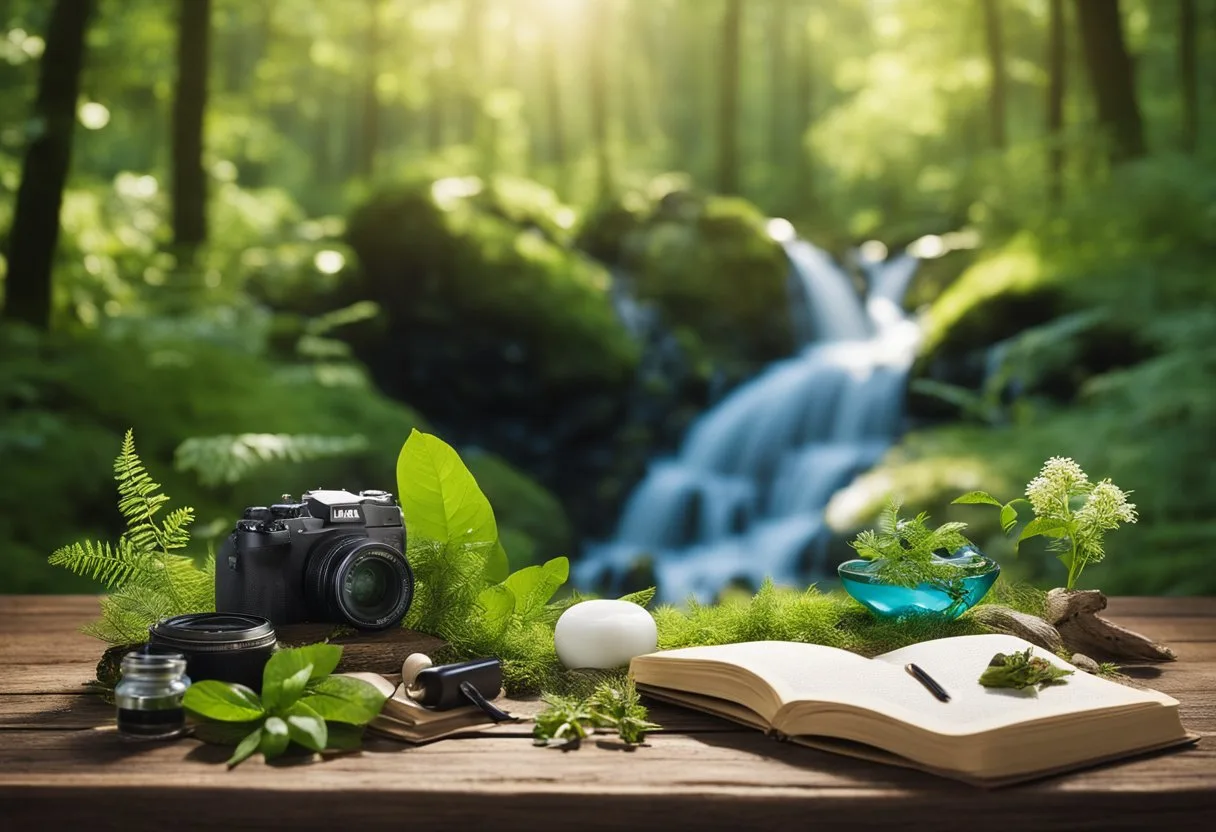Nature journaling is the act of recording observations and experiences in the natural world. It is a practice that has been around for centuries, with famous naturalists like John Muir and Charles Darwin keeping detailed journals of their explorations. The practice of nature journaling has many benefits, including improving observation skills and promoting a deeper connection with nature. In this blog post, we will discuss what is nature journaling, how it works and the reasons to start a nature journaling habit.
Observation is a key component of nature journaling. By taking the time to observe and record details about the natural world, individuals can develop a deeper appreciation for their surroundings. Through this practice, one can learn about the plants and animals in their environment and begin to see patterns and connections that may have gone unnoticed otherwise.
Nature journaling can be a fun and rewarding activity for people of all ages. It provides an opportunity to learn about the world in a hands-on way, while also promoting mindfulness and relaxation. Whether you are a seasoned naturalist or a beginner, nature journaling is a great way to explore the world around you.
Understanding Nature Journaling
Nature journaling is the practice of recording observations of the natural world through writing and art. It involves documenting experiences and observations of nature, including plants, animals, landscapes, and weather. Nature journaling can be done in many ways, from simple sketches and written notes to detailed drawings and scientific observations.
Historical Background
Nature journaling has a rich history, dating back to the time of John Muir Laws, a naturalist and artist who popularized the practice in the 19th century. Laws believed that nature journaling was a way to deepen one’s connection with the natural world and to develop a deeper understanding of the environment.
Benefits of Nature Journaling
Nature journaling has numerous benefits, including improving memory, observation skills, and creativity. It is also a way to reduce stress and improve mental health. It can be a valuable tool for scientific observation and research.
Through nature journaling, individuals can develop a deeper appreciation for the natural world and the interconnectedness of all living things. It is an opportunity to slow down, observe, and reflect on the beauty and complexity of nature.
Getting Started with Nature Journaling

Nature journaling is a great way to connect with nature and improve your observation skills. To get started, you will need to choose your tools, set up your first journal page, and develop your observation skills.
Choosing Your Tools
The first step in nature journaling is to choose your tools. You will need a notebook or sketchbook, a pencil or pen, and any other materials that you would like to use for drawing or coloring. Some people prefer to use watercolors or colored pencils, while others stick to simple black and white drawings.
When choosing your notebook, look for one that is small enough to carry with you but large enough to give you plenty of space to draw and write. You can also choose a notebook with pre-printed templates or create your own templates to use as a guide.
Setting Up Your First Journal Page
Once you have your tools, it’s time to set up your first journal page. Start by choosing a subject to draw or write about. This could be a plant, an animal, a landscape, or anything else that catches your eye.
Use your senses to observe the subject closely, taking note of its color, texture, shape, and any other details that you notice. Then, use your pencil or pen to sketch the subject on the page, adding any notes or labels that you would like to include.
You can also add color to your drawing using watercolors or colored pencils. Be sure to label your drawing with the name of the subject, the date, and any other relevant information.
Developing Observation Skills
One of the key benefits of nature journaling is that it helps you to develop your observation skills. To improve your observation skills, try to draw or write about something new every day. Use your senses to observe the world around you, taking note of the details that you might otherwise overlook.
As you practice, you will become more skilled at sketching, writing, and observing the natural world. Over time, you may even develop your own style of nature journaling that reflects your unique perspective and interests.
Nature journaling is a simple and effective way to connect with nature and improve your observation skills. By choosing your tools, setting up your first journal page, and developing your observation skills, you can get started with nature journaling today.
Nature journaling prompts
- Sketch various tree leaves and note identifying features.
- Observe a bird’s nest and document the activity.
- Collect and press wildflowers, noting their names and habitats.
- Record daily weather patterns and their effects on the local environment.
- Illustrate the insects you encounter and research their roles in the ecosystem.
- Measure the circumference of trees and compare growth over time.
- Identify and draw the different cloud types you see in the sky.
- Listen to the sounds of a stream and describe the rhythm and flow.
- Photograph the sunrise or sunset and write about the colors and emotions it evokes.
- Track the phases of the moon and their visibility each night.
- Note the plant species that thrive in different soil types in your area.
- Watch for animal behavior changes with the seasons and journal your findings.
- Draw a landscape from a favorite natural spot and note how it changes with the seasons.
- Record the different species of fish you observe in a local pond or stream.
- Document the blooming times of various plants and flowers in a garden or park.
How nature journaling works
Here is how nature journaling works:
1. Observation and Documentation
Nature journaling involves closely observing the natural world and documenting what you see. This can include drawing or painting plants, animals, insects, and landscapes; writing descriptions or narratives about your experiences; and noting details such as weather conditions, dates, times, and locations. The key is to capture both the details of the environment and your personal reflections or reactions to it.
2. Identification and Research
Part of nature journaling can be identifying the species you encounter and learning more about them. This may involve using field guides, apps, or online resources to identify plants, animals, and other natural elements. By researching, you can add informative notes to your journal entries, deepening your understanding of the ecosystem you are exploring.
3. Creative Expression
Nature journaling is not just a scientific activity; it’s also a form of creative expression. You can use various artistic mediums like pencils, watercolors, or even collage to capture the beauty of the natural world. This creative process helps foster a deeper connection with nature and can be a meditative and therapeutic practice.
4. Tracking Changes Over Time
Regular entries in a nature journal allow you to track changes in the environment over time. This could be seasonal changes, the growth of plants, the migratory patterns of birds, or even the impact of human activity on a particular landscape. This aspect of journaling can lead to a greater understanding of natural cycles and environmental changes.
5. Personal Growth and Learning
Nature journaling is a personal journey that promotes growth and learning. It sharpens observational skills, increases knowledge about the natural world, and can improve artistic abilities. It also encourages mindfulness and can increase one’s appreciation for the intricacies and wonders of nature, leading to a more environmentally conscious and appreciative mindset.
Benefits of nature journaling
1. Enhances Observation Skills
Nature journaling requires individuals to pay close attention to the details of the environment around them. By regularly recording observations, journalers become more attuned to subtle changes and details they might otherwise overlook. This heightened awareness can lead to a deeper understanding of nature and a greater appreciation for its complexity.
2. Encourages Mindfulness and Relaxation
Spending time in nature and focusing on the task of journaling can have a calming effect, reducing stress and anxiety. The act of drawing or writing in a journal encourages a person to be present in the moment, which is a core aspect of mindfulness. This can lead to improved mental well-being and a sense of peace.
3. Fosters Creativity and Artistic Expression
Nature journaling is a creative outlet that allows for the expression of personal artistic style. Whether through sketching, painting, or writing, individuals can explore different mediums and techniques to capture their experiences in nature. This creative process can be fulfilling and can help develop one’s artistic skills.
4. Supports Scientific Inquiry and Learning
For those with a scientific interest, nature journaling can serve as a method of inquiry and learning. It allows for the documentation of observations that can be used for personal study or shared with others. Journalers can track patterns, make hypotheses, and learn about ecology and biology through firsthand experience.
5. Promotes Environmental Stewardship
By spending time observing and documenting nature, individuals often develop a stronger connection to the environment. This connection can lead to increased awareness of environmental issues and a desire to protect natural spaces. Nature journalers may become advocates for conservation and take actions that support the health of the planet.
Advanced Techniques and Practices
Incorporating Scientific Methods
For those who wish to take their nature journaling to the next level, incorporating scientific methods can be a rewarding and rigorous approach. This involves using a more structured approach to observing and recording nature, including taking measurements, noting species identification, and recording environmental conditions. By doing so, naturalists can gain a deeper understanding of the natural world and make more accurate observations.
One useful technique is to use a field guide or app to identify different species. This can help to improve nature awareness and make it easier to record observations. Using a measuring tape or ruler can help to accurately record the size of animals or plants, while a thermometer can help to record the temperature.
Creative Approaches to Journaling
While using scientific methods can be useful, it is important not to forget the creative aspect of nature journaling. Creative approaches can help to make journaling more enjoyable and engaging, while also encouraging deeper connections with the natural world.
One approach is to experiment with different materials and techniques. For example, using watercolors or colored pencils can add a new dimension to illustrations, while experimenting with different styles of writing can make journaling more interesting. Incorporating poetry or stories can help to capture the wonder and beauty of nature.
Exploring Different Environments
Finally, to get the most out of nature journaling, it is important to explore different environments. This can help to broaden the range of observations and experiences, while also encouraging a more deliberate practice.
For example, exploring a local park or nature reserve can provide opportunities to observe different species and ecosystems, while visiting a beach or mountain range can offer a unique perspective on the natural world. Exploring different times of day or different seasons can help to capture the changing patterns and rhythms of nature.
By incorporating scientific methods, creative approaches, and exploring different environments, nature journaling can become a rewarding and fulfilling practice. Whether you are a naturalist looking to deepen your understanding of the natural world, or simply someone who enjoys spending time in nature, nature journaling can help to foster wonder, connections, and creativity.
Enhancing Your Nature Journaling Experience
Nature journaling is a personal, rewarding, and lifelong activity that can be enhanced in many ways. Here are some suggestions for improving your nature journaling experience.
Integrating Technology and Resources
While traditional nature journaling involves pen and paper, integrating technology and resources can enhance your experience. For example, using a camera or smartphone to take photos can help you capture details and moments that might be difficult to capture with a pen and journal alone. Online resources such as field guides, sound maps, and cloud identification tools can be used to supplement your observations and deepen your understanding of the natural world.
Joining a Community of Nature Journalers
Joining a community of nature journalers can provide support, inspiration, and opportunities for growth. Local nature journaling groups, online forums, and social media platforms are great places to connect with other nature enthusiasts and share your work. Participating in group events such as field trips, workshops, and classes can also provide opportunities to learn new skills and techniques.
Continuing Education and Events
Continuing education and events can help you develop your skills and knowledge as a nature journaler. Consider taking classes or workshops on topics such as wildlife, plants, insects, and fungi. Attending events such as conferences, festivals, and book signings can also provide opportunities to meet scientists, writers, and other experts in the field. By continuing to learn and grow, you can deepen your appreciation for the natural world and improve your nature journaling practice.
Enhancing your nature journaling experience can be a playful, personal, and scientific journey. By integrating technology and resources, joining a community of nature journalers, and continuing your education, you can create a lifetime of meaningful and rewarding nature journaling experiences.
Frequently Asked Questions
What are the essential supplies needed for nature journaling?
Nature journaling requires minimal supplies, including a notebook, pen or pencil, and a willingness to observe and record the natural world. However, some additional supplies that may enhance the experience include watercolors, colored pencils, and a magnifying glass for close-up observations.
How does nature journaling benefit personal well-being?
Nature journaling has been shown to have numerous benefits for personal well-being, including reducing stress and anxiety, increasing mindfulness and self-awareness, and improving overall mood and emotional regulation. By connecting with nature and recording observations, individuals may also experience a greater sense of purpose and connection to the world around them.
What are some effective prompts for adults starting out with nature journaling?
Effective prompts for adults starting out with nature journaling may include focusing on a specific plant or animal, observing changes in the natural world over time, or recording sensory experiences such as smells or sounds. Using guided prompts or participating in group events such as International Nature Journaling Week may provide inspiration and support for beginners.
Can nature journaling be used as an educational tool, and if so, how?
Nature journaling can be a powerful educational tool, providing opportunities for hands-on learning and fostering curiosity and critical thinking skills. Educators may use nature journaling to teach topics such as biology, ecology, and environmental science, or to promote interdisciplinary learning across subjects.
What are the best practices for recording observations in a nature journal?
Best practices for recording observations in a nature journal include using descriptive language, drawing or sketching observations, and including specific details such as location and weather conditions. It is also important to date entries and to revisit previous observations to note any changes or patterns over time.
How does participating in events like International Nature Journaling Week enhance the journaling experience?
Participating in events like International Nature Journaling Week can enhance the journaling experience by providing a sense of community and shared purpose, as well as access to resources and prompts to inspire creativity and exploration. It may also provide opportunities for individuals to connect with nature in new and meaningful ways, and to develop a deeper appreciation for the natural world.




